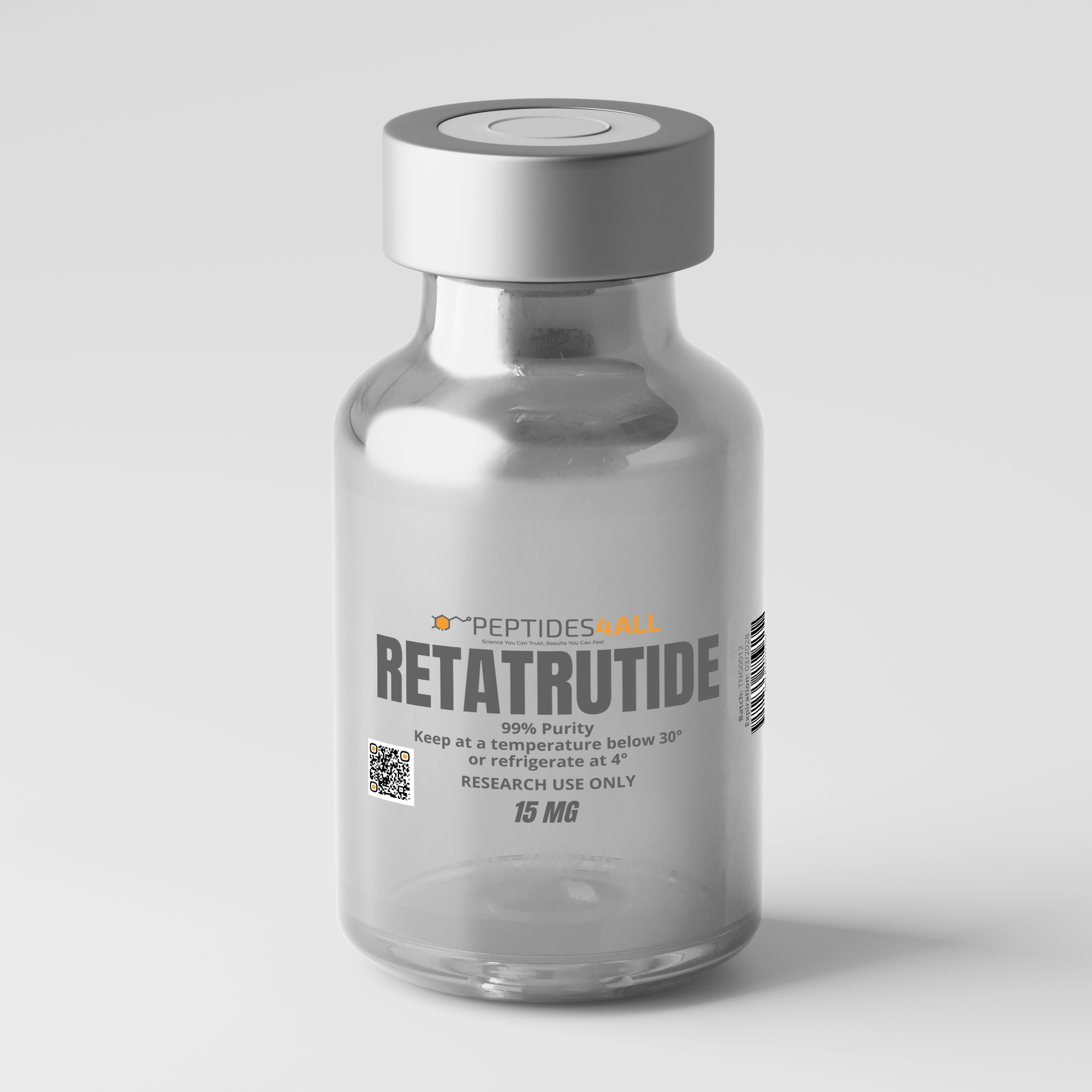PEPTIDES4ALL Retatrutide (LY-3437943) – Triple Receptor Agonist Peptide for Metabolic & Obesity Research
PEPTIDES4ALL Retatrutide (LY-3437943) is a synthetic peptide-based triple agonist that simultaneously activates GLP-1 (glucagon-like peptide-1), GIP (glucose-dependent insulinotropic polypeptide), and glucagon receptors—three key hormonal pathways that collectively regulate appetite, glucose metabolism, and energy expenditure.
Developed as a next-generation incretin mimetic, Retatrutide represents a new class of multi-receptor metabolic peptides designed to produce superior weight loss and metabolic improvements compared to single or dual agonists.
By engaging this triad of metabolic receptors, Retatrutide triggers coordinated effects on satiety, lipid metabolism, hepatic fat oxidation, and thermogenesis, providing an integrated framework for studying obesity, diabetes, and metabolic liver disease.
Its unique receptor balance—strong GLP-1 agonism with balanced GIP and glucagon co-activation—underpins its triple mechanism: reducing food intake, increasing energy expenditure, and enhancing glucose control (New England Journal of Medicine, 2023; PMC10990385; PMC+3ScienceDirect+3NovoPro Labs+3)
Mechanism of Action & Receptor Pharmacology
Retatrutide mimics the natural incretin system but extends its reach to glucagon signaling, creating a harmonized metabolic response:
-
GLP-1 Receptor Agonism: Promotes satiety, delays gastric emptying, enhances insulin secretion, and improves glycemic control.
-
GIP Receptor Agonism: Enhances insulin sensitivity and potentiates GLP-1 activity in pancreatic β-cells, contributing to glucose stability (PMC10474373).
-
Glucagon Receptor Agonism: Increases energy expenditure through hepatic and adipose fat oxidation while preserving lean mass (ScienceDirect, 2024)).
The triple-agonist design allows Retatrutide to balance anabolic and catabolic processes—supporting weight reduction while improving metabolic efficiency.
Scientific Evidence & Research Findings
In preclinical models and early human trials, Retatrutide has demonstrated:
-
Potent Weight Reduction
In Phase 2 clinical trials involving overweight and obese adults, Retatrutide induced up to 24.2% mean body-weight reduction over 48 weeks, outperforming dual GLP-1/GIP agonists (NEJM, 2023).
This effect is driven by both appetite suppression and elevated energy expenditure, positioning Retatrutide as one of the most potent investigational anti-obesity agents to date. -
Enhanced Glycemic & Lipid Control
Subjects experienced significant improvements in HbA1c, fasting glucose, and lipid panels, with marked reductions in triglycerides and LDL cholesterol (PMC10990385).
These effects parallel enhanced insulin sensitivity and decreased hepatic steatosis. -
Gastrointestinal Dynamics
Retatrutide delays gastric emptying, prolonging nutrient absorption and reinforcing satiety signals, thereby contributing to sustained caloric control (PMC11450997). -
Liver & Renal Outcomes
In early-stage studies for metabolic dysfunction-associated steatotic liver disease (MASLD), Retatrutide reduced intrahepatic triglyceride accumulation and improved overall liver function metrics (ScienceDirect, 2024).
Preliminary findings also suggest beneficial effects on renal perfusion and glomerular metabolism, making it relevant to chronic metabolic disease models.
Key Research Benefits & Applications
-
Triple Receptor Activation — Simultaneously agonizes GLP-1, GIP, and glucagon receptors to modulate appetite, energy expenditure, and metabolic regulation.
-
Weight Loss & Appetite Regulation — Reduces body weight via both reduced caloric intake and metabolic shifts.
-
Gastrointestinal Kinetics — Slows gastric emptying, contributing to satiety.
-
Metabolic & Organ Benefits — Demonstrated improvements in glycemic control, liver fat, lipid profiles, and possibly renal and cardiovascular parameters.
Presentation & Handling
- Form: Supplied as lyophilized peptide in sterile vial.
- Reconstitution: Use bacteriostatic water or 2% procaine; swirl gently (do not shake vigorously).
- Storage: Store at –20 °C, protected from light and moisture. After reconstitution, use according to research protocols and handle under sterile conditions.
Intended Use
For research purposes only. Must be handled in accordance with institutional protocols and ethical guidelines.
